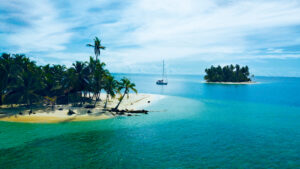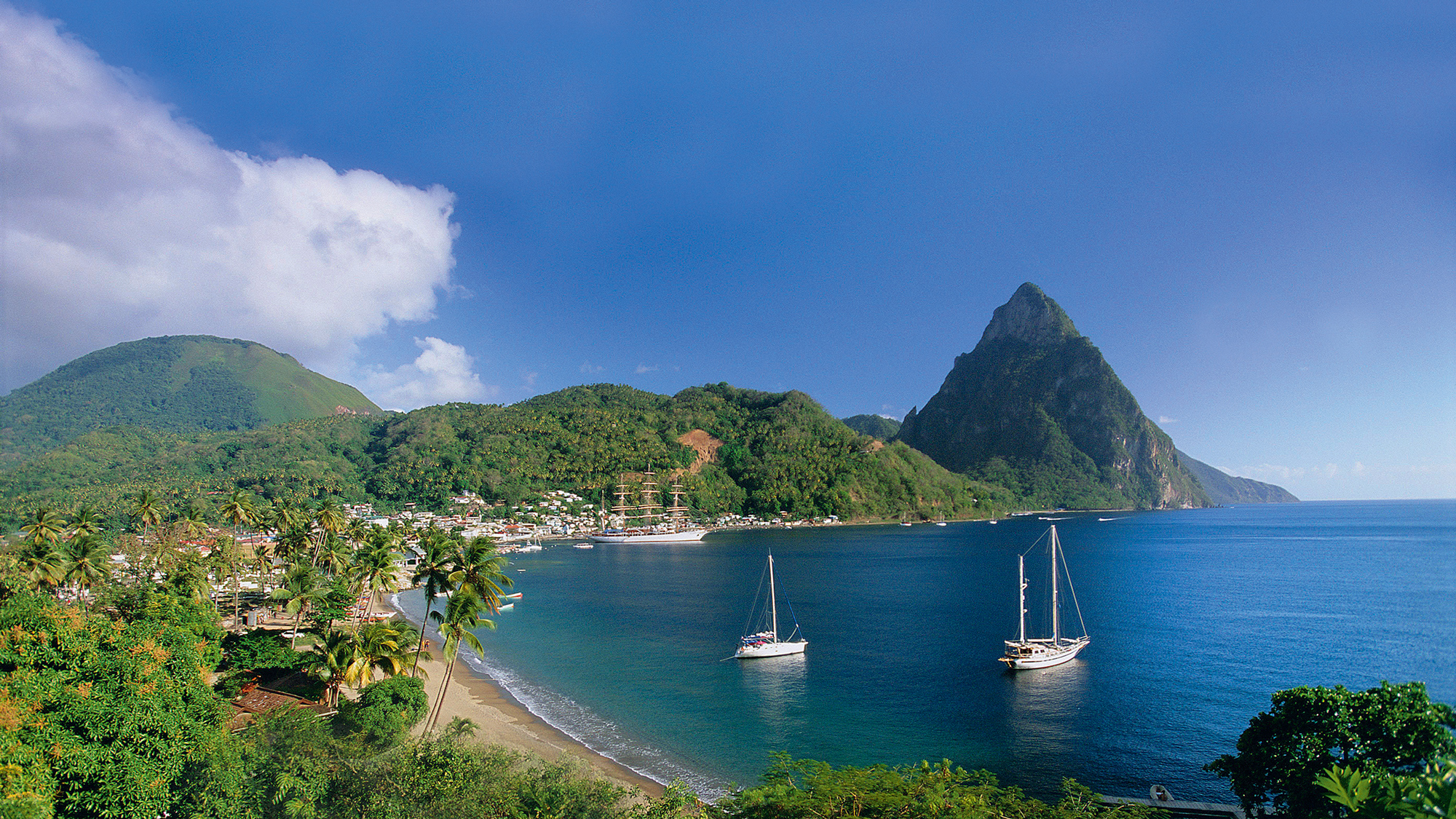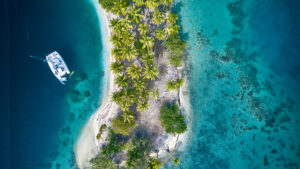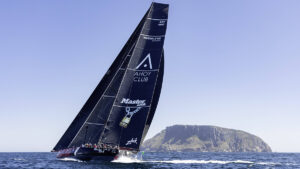Sailing central America in lightning season was a balance of risk and reward for Charlotte DC and JP Baudains
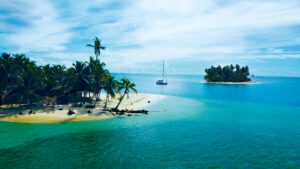
I’ve always found local winds fascinating. One year in France, while racing a Q Class in a classics regatta, a whole fleet of spinnakers blew up ahead of me as a waterspout ripped through the course with the Mistral – a wind so infuriating that it was written into old French law that if it blows for over nine days a cold-blooded murder simply becomes a ‘crime of passion’.
Cruisers hoping to enjoy a calm summer in the Greek Islands are often shocked by the Meltemi, a wind that jumps from 12 to 40 knots with little prior warning. And in a remote atoll in French Polynesia we found ourselves in boat lockdown whilst the Maramu raged through – a strong persistent sou’wester that can often last over a week.
The winds and storms that dominate the summer skyline in Panama and Columbia have been named the ‘Caleo de Pollo’, or in other words winds so powerful that they make the branches of a palm tree slick straight back to resemble ‘Feathers of the Chicken’.
The treacherous concoction of Atlantic weather accumulating into this hot melting pot has earned the sail from the north coast of Columbia to Panama a place on the top five most dangerous passages in the world – and, in order to make our Panama Canal slot, we had to do it at the worst possible time of year.
We – my partner JP and I – met four years ago working on the prestigious 55m modern classic ketch Marie and the racing maxi Leopard 3. Soon after, our combined dream of circumnavigating became a reality when we bought a yacht to call our own.
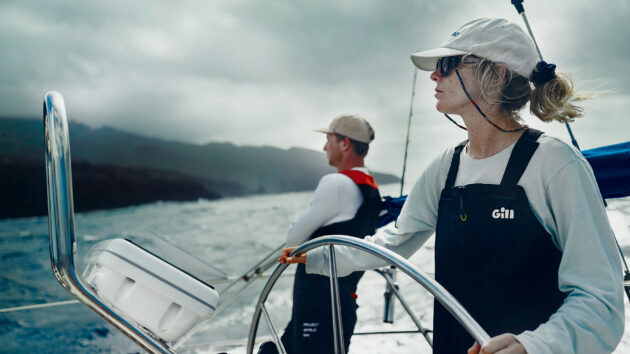
The author Charlotte DC and partner JP Baudains aboard their yacht Jacqeau. Photo: Niklas Sandstrom courtesy of PWS
Since then, we’ve split our time between running and racing yachts professionally and sailing our yacht Jacqeau around the world. After an intense refit in Newport, Rhode Island, we sailed Jacqeau down to the Caribbean, where we ran an Oyster 575 for the season, before sailing (the wrong way) home to explore the stunning cruising grounds of the UK.
The following year, we recrossed the Atlantic, then picked up an Oyster 72 in Antigua to run for the season.
So, having delivered the Oyster to the US, it was early June by the time we flew back to Jacqeau’s shipyard in Antigua. The travel lift, which had been put to bed for the summer, gave a hydraulic sigh as it was powered back up.
Jacqeau was lifted and carefully manoeuvred through the maze of boats which had been strapped down for the hurricane season. If there was ever a sign that we shouldn’t be sailing, this was it. However, it was the earliest opportunity we had and before we knew it, we were on passage towards Colombia.
Strong and consistent trade winds combined with current had us off to a flying start and spirits were high as we were completing 200-mile days at a time. Those spirits were quickly dampened, however, as we reached the northern coast of Colombia from Antigua.
Sailing the Caribbean Sea between Santa Marta and Cartagena presents sailors with such a myriad of difficulties that the favoured route is to keep well offshore and stay clear of this danger zone. For us, this would have meant two days of beating upwind, into three knots of current, to get into the city of Cartagena, so we decided to go coastal.
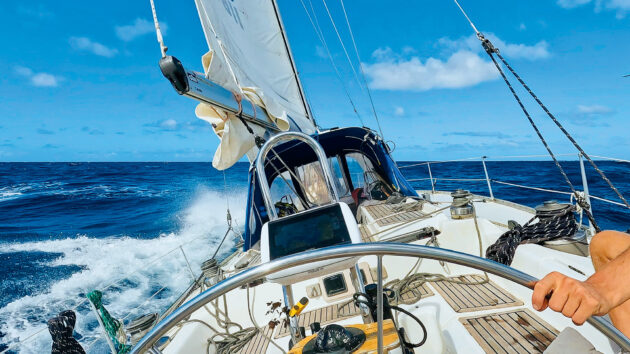
Reefed for the upwind passage on the approach to Cartagena. Photo: Project World Sail
River’s mouth
Forty-eight hours into our passage and the day had become blisteringly hot. And while the evening offered a refuge from the heat, the smattering of flashes that appeared with the night sky were worrying. What started as distant sparks became more and more prevalent with every mile that we drew closer to our destination.
The final 24-hour approach to Cartagena proved challenging. We were sailing past Barranquilla which, for tourists, is famous for its flamboyant carnival and local culture. But for sailors it’s known for the mouth of the Magdalena River. The largest river in the Northern Andes, this river flows at a rate of up to 420 cubic feet a second, making its local effect on the surrounding sea unpredictable and extremely hazardous.
To make things even more intense, June marks the time of year when the Intertropical Convergence Zone (ITCZ) causes the predominant easterly trade winds and currents to battle it out with a south-westerly coming up from Panama. And of course, this mêlée of weather hit us at 0400 – a time which, although not statistically proven, many sailors will tell you with absolute conviction is when the worst things happen.

The joy and relief of a golden sunset and a clear night sky. Photo: Project World Sail
Just before sunset the previous evening the easterly wind had dropped significantly, making the apparent too low for sailing. Dripping with sweat we dropped and flaked our main sail, then turned the engine on. This turned out to be our saviour in the night that followed.
As darkness fell, the gently rolling Caribbean swell turned into short, sharp waves coming from every direction. The surging river mouth creates a significant change to the density of the water forming complex currents, oceanic eddies and a steep increase in velocity.
Article continues below…
‘It quickly becomes clear that things are not good. What follows is a blur of suppressed panic and a mad fumbled search of the boat…’
Friday evening, 21 February, 2025, and we are anchored inside a reef lagoon in a remote part of Raja Ampat,…
Saint Lucia: not just a transatlantic stopover
At the end of a long transatlantic crossing, the island of Saint Lucia is a dreamlike landfall. Its hills and…
We’d be surfing down a wave at the same time as getting soaked by another hitting us beam on. The wind dial pranced from four to 40 knots and sleep became out of the question. Nature’s firework display commenced for the night as bright yellow patches popped up on the radar, so opaque that, if you didn’t have charts, you could be mistaken for thinking they were land.
Unsurprisingly, our log entries were limited that night, although a 0600 comment read: ‘Avoid all lightning – CHECK’. We’d spent a tireless night weaving our way through the maze of foreboding blobs on our radar so the slim line of orange appearing on the horizon brought us hope for a new day.
The Caribbean current that had worked so well in our favour at the start of the trip continued flowing east as we turned to port and headed down the coast. We were now working against both wind and current. Suddenly, something caught my eye in the water ahead: something big. On closer inspection it was a huge floating log, at least half the length of our boat and about a metre across.
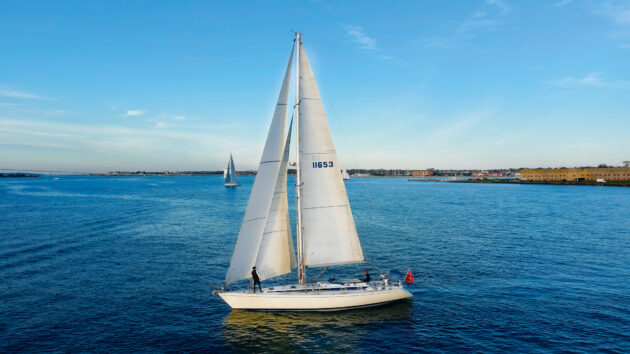
Jacqeau’s elegant Germán Frers-designed lines were built in Brazil. Photo: Elevate Drone Media courtesy of PWS
With the strong current pushing it towards us this could easily have broken a hole in our hull. I scanned across to see an army of similar tree trunks heading in our direction – Jacqeau was under attack.
We weaved through the obstacle course, straining our already tired eyes to ensure we avoided them all. Apparently it’s commonplace for debris to be swept out of the river here, we even heard reports of a whole house flowing downstream, so felt lucky not to have encountered any worse.
It’s pretty much impossible not to have an upwind sail to Cartagena at that time of year so we spent the day slowly but surely pushing our way closer to the city. Despite a small boat entrance with a chart depth of 2.6m we were told by the Coastguard there was absolutely no possibility we could make it through with our draught of 2.3m. The longer route round added another arduous eight miles to the journey and we eventually crept into the city anchorage at twilight.
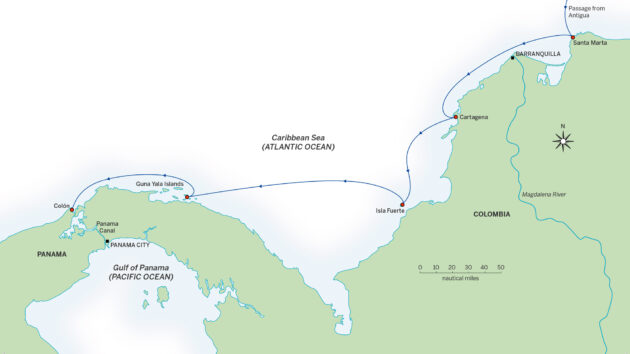
The route
Colombian colour
Arriving in Cartagena was a shock to the system. We’d spent the summer before exploring deserted anchorages in Scotland and the winter in sleepy Caribbean bays. Now, after six days at sea, we were met with towering skyscrapers, speedboats blasting out music and the redolent smell of a city.
When we set off on our circumnavigation from New England in 2022 we’d imagined uninhabited islands and white sand beaches. But the novelty of anchoring in the middle of a thriving city has to be up there with our best moments.
Jacqeau was designed by the legendary Germán Frers in his home country of Argentina and then built in South America’s most prestigious shipyard at the time in Brazil. She was part of a small fleet of ‘Fast Yachts’ (one of which Frers designed for himself) and has been the only one since to have left the country.
Bringing her back to Latin America felt like bringing her home and she sat in the middle of the murky brown city anchorage looking just as impressive as the metropolis that surrounded her.
As for the city itself, we fell in love. We spent our time in port exploring the vibrant alleyways of the old town that teemed with delicious food, drink and culture. We’d sit in rooftop bars at sunset and watch the lightning roll in over the ocean, blissfully ignoring the fact that it was exactly what we would have to face at sea in a couple of days.
Then, with bellies and hearts full, we pulled away from what had been one of our favourite stops so far and set off again into the night. Our next intended destination was the Guna Yala Islands, San Blas – a mere 200-mile passage that ended up being one of our worst yet.
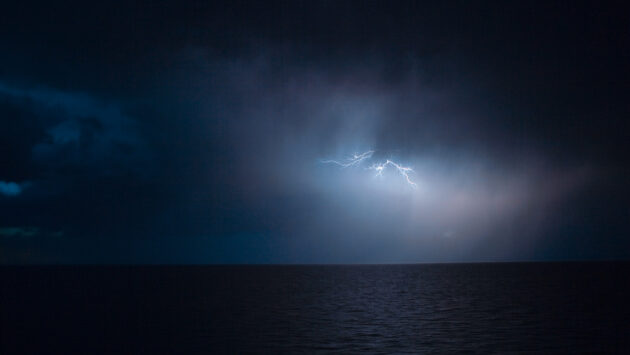
Electrical storms are an ever present danger in South American waters in June. Photo: Holger Leue/Getty
A game of luck
There’s absolutely no avoiding lightning at this time of year. The reality is, if you’re sailing at night, there will be lightning around and sure enough, like turning on a switch at sunset, forks of electricity began to crackle around us as soon as darkness fell.
In the dead of the night two small dots popped up on either side of us on the radar. Within 20 minutes they had become colossal thunderstorms. We checked our speed and heading against theirs and it looked like we were going to get ahead of them.
But then we experienced something neither of us had ever seen before; the thunderstorms on either side started to move towards each other as if they were homing in on a target and that target was us. Before we knew it they had merged and we were directly in the heart of the tempest.
Everything was pitch black, 30-plus knots of wind and heavy rain pounded us as we leapt to control the sails.
Deafening roars of thunder coincided simultaneously with mammoth bolts of lightning hitting the sea all around. Nothing can prepare you for how loud the thunder and how blinding the lightning is when you’re that close to it. Jacqeau crashed up and down against the steep surface waves making excruciatingly slow progress. We were getting nowhere and whenever we looked at the radar the storm was only getting larger.

JP keeping an eye on the ever-changing conditions. Photo: Andreas Müllner courtesy of PWS
We spent the following hour battling through severe conditions. With each lightning bolt we couldn’t help but think ‘this is it’. Sailing with a 20m aluminium pole in the sky amid such a storm makes you feel exceedingly vulnerable.
If we were hit, at best we’d lose our electrics, while at worst it could breach our hull. Ever so gradually, however, the lightning moved behind us and we watched in relief as it ripped mayhem through the empty waters in our wake.
Exhausted, soaked through, and with our nervous systems wrecked, we made the decision to take a detour and seek refuge for the following night. The sun brought a literal light at the end of the tunnel as it appeared on the horizon and weaved its way through the dark, dense squall lines. Under its warmth, we couldn’t help but feel an overwhelming sense of relief. We had never found ourselves so much in the hands of nature than we had in that storm and it was sheer luck that we didn’t get hit.
We found an appropriate port of refuge due south and anchored off Isla Fuerte for the night where we dried out, caught up on sleep and prepared for the next stage.
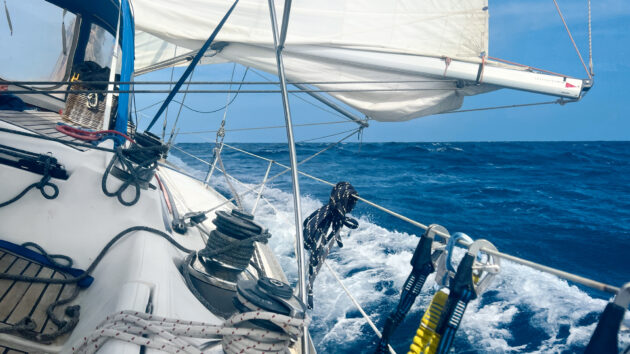
A cracking start to the passage doing 200-mile days out of Antigua. Photo: Project World Sail
Before we set off again, we spent some time de-briefing the night before. We knew we’d experience more lightning for the next couple of weeks at sea, so we wanted to learn as much as possible to minimise the risk. These are our main takeaways:
- Prediction – While forecast tools like ‘thunderstorms’ on Windy can give a rough indication, exact locations and durations are rarely accurate. We looked closely at CAPE Index (connective available potential energy, ie the amount of potential fuel available for a developing thunderstorm) and made ourselves aware of what was considered high or low for the part of the world we were in. We also used live satellite imagery to give us a better indication of what is happening at that moment.
- Avoidance – The wind shear and downdrafts produced by thunderstorms cause them to move in various unpredictable directions. Thunderstorms can extend up to 15km vertically, and therefore some are being pushed along in the upper atmosphere and moving in a completely different wind direction to the lower atmosphere. We made sure that we were looking at wind predictions for much higher altitudes to see if there were any trends we needed to be aware of.
- Preparation – If lighting came close to us, we prepared by ensuring we had a non-electronic communication source (handheld radio or sat phone), unplugging any electrics, wearing rubber soled shoes, keeping the engine running (starter battery wouldn’t work if struck), ensuring the boat was properly grounded, and shortening sail to anticipate high winds.
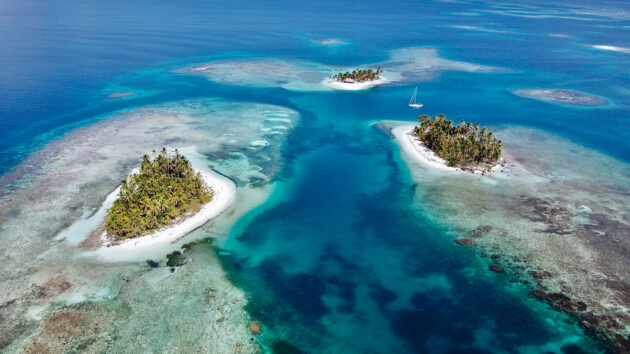
Perfect reward for a demanding passage: a private anchorage in paradise. Photo: Project World Sail
Guna Yala
Thankfully our second attempt at the same passage was much more successful. Despite watching cumulonimbus clouds grow twice the size of Everest during the day, the worst of it passed behind us for the night and we observed the lightning from a safe distance as we glided eastwards in the dark. Just over 24 hours later we caught our first glimpse of the highly anticipated Guna Yala.
This 365-strong island archipelago has long since been part of the ‘Milk Run’, with many considering it a true paradise. But for us, it felt like a whole new world. After contending with the perilous Magdalena river mouth and nerve-racking lightning-filled nights, to see a perfect copse of palm trees spring from an azure blue sea felt like a mirage.
We meandered our way through the web of reefs to a spot between three perfect miniature islands. As the anchor dropped, two friendly nurse sharks swam up to our stern as if to welcome us to this much-needed safe haven (they ended up staying with us for the duration of our time there, and we fondly nick-named them Simon and Garfunkel). We spent the next few days living an idyllic life of catching fish, exploring reefs and meeting the few passing locals as they gracefully sailed from island to island in their wooden boats.
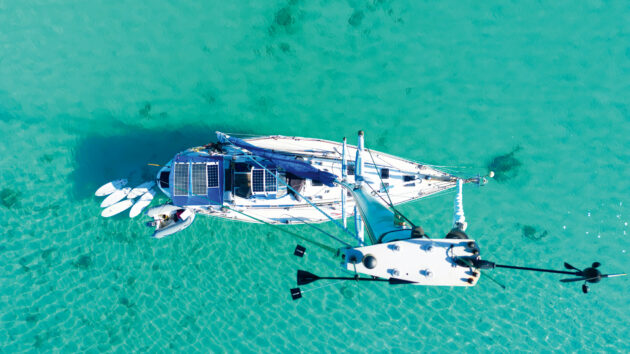
Charlotte and JP’s Jacqeau in the crystal clear waters of San Blas. Photo: Andreas Müllner courtesy of PWS
Crowd avoidance
Our final spot was Bug Island, usually a crowded anchorage frequented by the various world rally fleets. Being so late, however, we were left with ample room to pick a spot in the flawless turquoise water.
That night we visited Ibin from the self-named ‘Ibin’s Beach Restaurant’. Weeks had gone by since his last visitor and he greeted us open-armed like old friends. His wooden platformed bar is delicately perched over the water’s edge, clad in hundreds of yachts’ flags, each frayed edge telling a different tale of a life lived at sea.
He offered us a tot of his finest Panamanian rum and cheerily told us how this time last year someone got so badly struck by lightning in the anchorage that it blew a hole in their hull and started to sink. Chuckling away to himself he filled us up with pizzas and beers and sent us away with the largest homemade focaccia I have ever seen.
We could have spent many more weeks exploring the countless islands of this archipelago but sadly our Panama Canal slot was only a few days away.
As we joined the traffic jam of towering cargo ships heading towards Colón I reflected on the past two weeks at sea. Would I recommend sailing though Colombia and Panama in June? Absolutely not. The reward, however, was quite remarkable.
We left grateful for our chance to share this indigenous land with only the locals and a couple of friendly nurse sharks. Experiencing the contrasting energies of the vibrant, dynamic streets of Cartagena with the spectacularly beautiful, deserted islands of the Guana Yala was worth its weight in gold.
 If you enjoyed this….
If you enjoyed this….
Yachting World is the world’s leading magazine for bluewater cruisers and offshore sailors. Every month we have inspirational adventures and practical features to help you realise your sailing dreams.Build your knowledge with a subscription delivered to your door. See our latest offers and save at least 30% off the cover price.
Note: We may earn a commission when you buy through links on our site, at no extra cost to you. This doesn’t affect our editorial independence.
The post ‘Deafening roars of thunder coincided simultaneously with mammoth bolts of lightning hitting the sea all around us’ appeared first on Yachting World.
